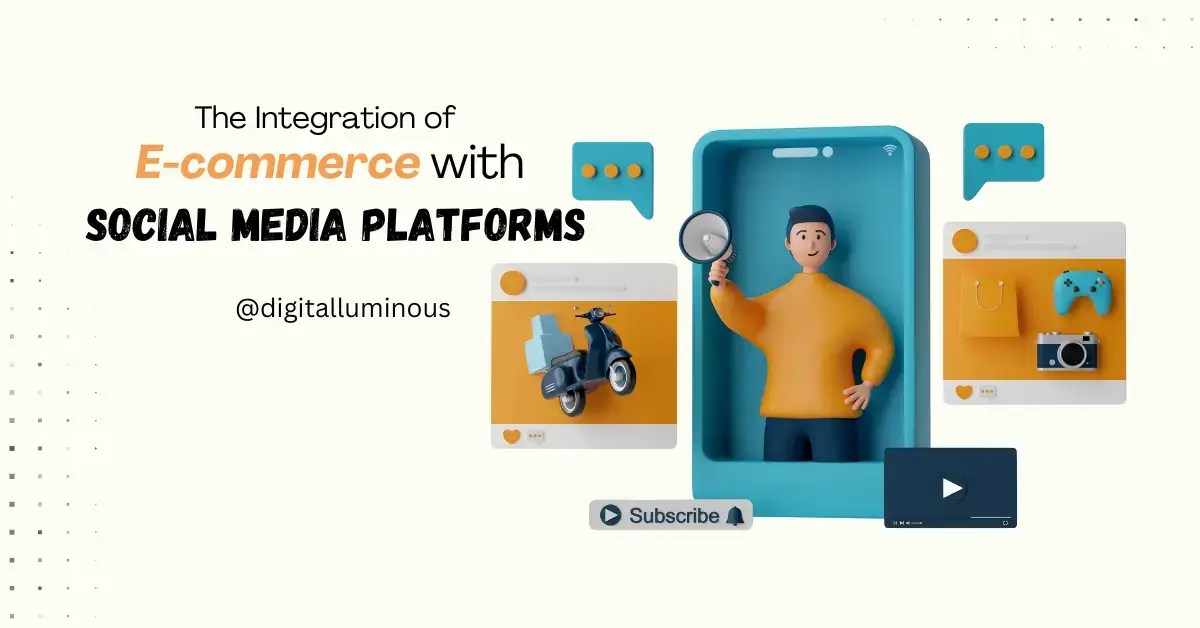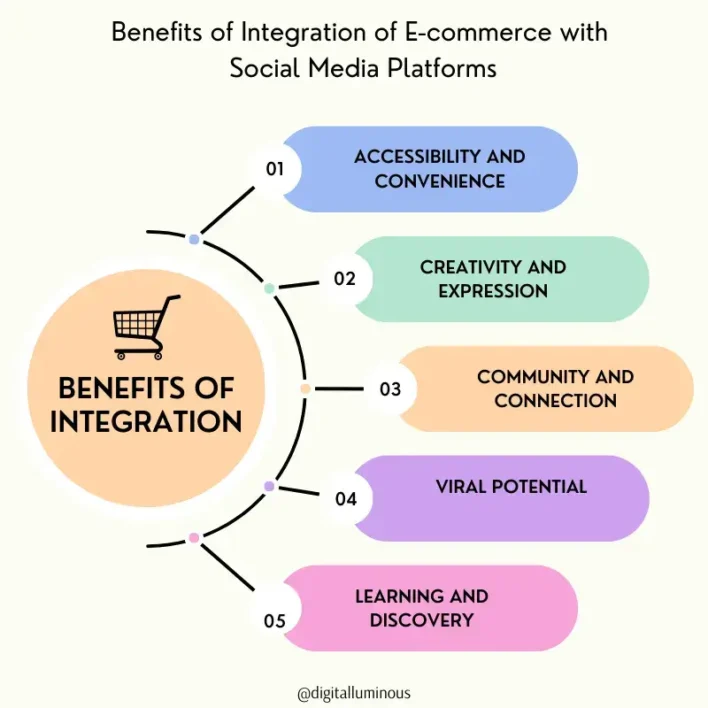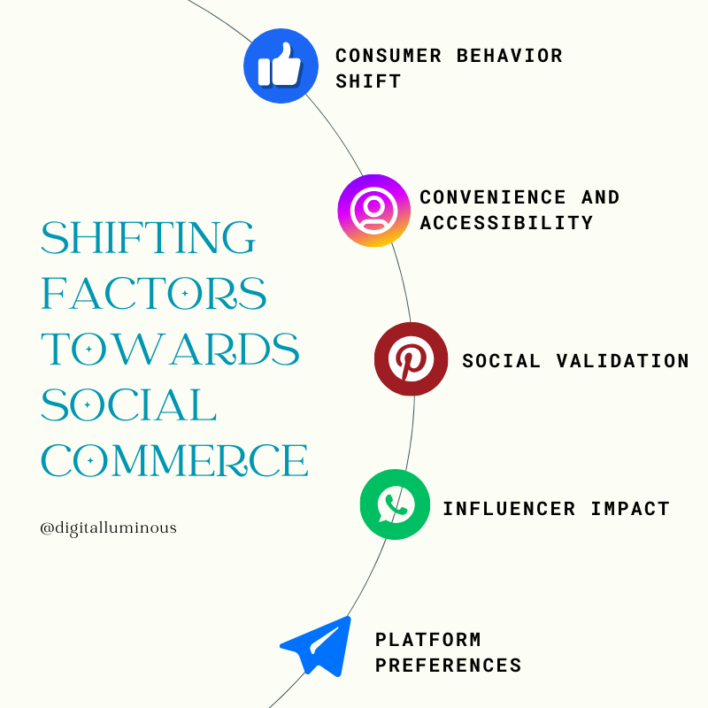
In the digital landscape, the integration of e-commerce with social media platforms has emerged as a transformative force, reshaping the way businesses engage with consumers and conduct online transactions.
This comprehensive exploration delves into the multifaceted impact of this integration, covering various aspects such as consumer behavior, technological advancements, and business strategies.
What is The Integration of E-commerce with Social Media Platforms?
The integration of e-commerce with social media platforms refers to the seamless incorporation of online shopping functionalities within social networking sites and apps.
Traditionally, social media platforms served as channels for communication, content sharing, and community building.
However, with the rise of e-commerce, these platforms have evolved into powerful sales channels where businesses can showcase their products, engage with customers, and facilitate transactions directly within the social media environment.
This integration encompasses a range of features and tools that enable businesses to leverage the vast reach and engagement potential of social media for driving sales and revenue.
From shoppable posts and in-app purchases to personalized recommendations and influencer marketing, e-commerce integration with social media platforms offers businesses unprecedented opportunities to monetize their social presence and capitalize on consumer behavior trends in the digital age.
Benefits of Integration of E-commerce with Social Media Platforms:

- Accessibility and Convenience: Short-form video platforms like TikTok and Instagram Reels are designed for mobile devices, allowing users to access content anywhere, anytime, even on the go.
A college student watches cooking tutorials on TikTok while taking a break between classes, learning new recipes in just a few minutes.
- Creativity and Expression: User-Friendly Editing Tools: Short-form video platforms offer intuitive editing tools and filters that enable users to express their creativity and produce visually appealing content.
A makeup enthusiast showcases her skills by creating short makeup tutorials on Instagram Reels, demonstrating different techniques and product recommendations.
- Community and Connection: Short-form video platforms foster engagement through features like comments, likes, and shares, allowing users to interact with content creators and fellow users.
A fitness enthusiast joins a community of runners on TikTok, sharing workout routines, progress updates, and encouraging messages with fellow runners.
- Viral Potential: Short-form video platforms employ algorithms that prioritize engaging content, increasing the likelihood of videos going viral and reaching a large audience.
A comedic skit on TikTok garners millions of views and shares within hours of being posted, spreading laughter and entertainment worldwide.
- Learning and Discovery: Short-form video platforms serve as valuable learning resources, offering tutorials, how-to guides, and educational content on diverse topics.
An aspiring photographer learns photography tips and techniques from professional photographers on YouTube Shorts, improving their skills and expanding their creative repertoire.
Key components of e-commerce integration with social media platforms

- Shoppable Posts and Product Tags: Social media platforms such as Instagram and Facebook allow businesses to tag products directly in their posts and stories, transforming static content into interactive shopping experiences.
Sarah creates a series of captivating posts showcasing her latest jewelry collections. With Instagram’s shoppable posts feature, she tags each product with a “Shop Now” button, allowing users to click on the products they like and view detailed product descriptions and prices directly within the app.
- In-App Purchases and Checkout: Some social media platforms enable businesses to integrate e-commerce functionalities directly into their profiles, enabling users to browse, select, and purchase products within the platform’s ecosystem.
Upon clicking on a product tag, users are redirected to Sarah’s Instagram shop, where they can browse through her entire product catalog.
Users can easily add items to their cart and proceed to checkout without leaving the Instagram app, streamlining the purchase process and reducing friction.
- Personalized Recommendations and Targeted Advertising: Social media platforms leverage user data and machine learning algorithms to deliver personalized product recommendations and targeted advertisements based on users’ interests, preferences, and past behavior.
Instagram’s algorithm analyzes user engagement with Sarah’s posts and identifies users who have previously expressed interest in jewelry or similar products.
Based on this data, Instagram delivers personalized recommendations to users’ feeds, featuring Sarah’s jewelry collections and promotional offers tailored to their interests and preferences.
- Influencer Marketing and Social Proof: Influencers play a pivotal role in driving product discovery and purchase decisions on social media platforms, leveraging their influence and credibility to endorse products and engage their followers.
Sarah collaborates with popular fashion influencers on Instagram to showcase her jewelry to a wider audience. Influencers create sponsored posts featuring Sarah’s products, sharing their personal experiences and styling tips with their followers.
These endorsements leverage the influencers’ credibility and influence to drive product discovery and encourage purchases among their followers.
- Analytics and Performance Metrics: E-commerce integration with social media platforms provides businesses with robust analytics and performance metrics to track the effectiveness of their marketing campaigns, measure return on investment (ROI), and optimize their strategies.
Sarah monitors the performance of her Instagram shop using Instagram Insights, a built-in analytics tool that provides valuable insights into her audience demographics, engagement metrics, and sales performance.
By analyzing these metrics, Sarah gains actionable insights into the effectiveness of her marketing efforts and identifies areas for optimization to maximize her sales revenue.
Understanding Consumer Behavior

- Consumer Behavior Shift: Traditional e-commerce models are witnessing a significant shift as consumers increasingly turn to social media platforms for product discovery, recommendations, and purchase inspiration.
Rather than relying solely on search engines or e-commerce websites, consumers are now leveraging social media channels to explore new products, gather feedback, and make informed purchasing decisions.
- Convenience and Accessibility: The allure of social commerce lies in its convenience and accessibility. Social media platforms offer users a seamless transition from browsing to purchasing within the same environment.
With a few taps or clicks, users can explore product catalogs, view customer reviews, and complete transactions without leaving their favorite social media app.
- Social Validation: Social commerce satisfies the innate human desire for social validation.
Users seek reassurance and approval from their peers when making purchasing decisions, and social media platforms serve as virtual gathering places where users can seek opinions, recommendations, and feedback from friends, family, and online communities.
- Influencer Impact: Influencer marketing has played a pivotal role in driving the shift towards social commerce. Influencers, with their large and engaged followings, have the power to sway consumer opinions and preferences.
By partnering with influencers to showcase products and share authentic experiences, brands can tap into their influence to reach new audiences and drive sales.
- Platform Preferences: Different social media platforms cater to varying consumer preferences and demographics.
For example, Instagram is popular among younger demographics for its visual-centric nature and influencer culture, while Facebook appeals to a broader audience demographic. Understanding these platform nuances is crucial for businesses looking to capitalize on the shift towards social commerce.
Conclusion
The integration of e-commerce with social media platforms represents a convergence of digital technologies and consumer behavior, reshaping the retail landscape and redefining the shopping experience.
Businesses that embrace this integration stand to benefit from enhanced engagement, increased sales, and deeper connections with their audience.
As technology continues to evolve and consumer expectations evolve, the synergy between e-commerce and social media will continue to evolve, presenting new opportunities and challenges for businesses in the digital era.
FAQs
What is the integration of e-commerce with social media platforms?
It refers to incorporating online shopping functionalities within social networking sites and apps to facilitate seamless transactions and sales directly within the social media environment.
Why is the integration of e-commerce with social media platforms significant?
It allows businesses to leverage the vast reach and engagement potential of social media for driving sales, enhancing customer experiences, and building brand loyalty.
Which social media platforms offer e-commerce integration features?
Platforms such as Instagram, Facebook, Pinterest, and Snapchat provide various e-commerce integration tools, including shoppable posts, in-app purchases, and personalized recommendations.
What are the benefits of integrating e-commerce with social media platforms for businesses?
Benefits include expanded reach, increased sales opportunities, improved customer engagement, enhanced brand visibility, and access to valuable customer data for targeted marketing.
How do shoppable posts and product tags work on social media platforms?
Shoppable posts and product tags enable businesses to tag products directly in their posts or stories, allowing users to browse, view product details, and make purchases without leaving the platform.
What are in-app purchases and checkout options on social media platforms?
In-app purchases and checkout options enable users to browse, select, and purchase products directly within the social media app, streamlining the buying process and reducing friction for customers.
How do personalized recommendations and targeted advertising contribute to e-commerce integration?
Personalized recommendations and targeted advertising leverage user data and algorithms to deliver tailored product suggestions and promotional content, increasing the relevance and effectiveness of marketing efforts.
What role do influencers play in e-commerce integration with social media platforms?
Influencers collaborate with brands to promote products to their followers, leveraging their influence and credibility to drive product discovery, generate sales, and foster brand advocacy.
Can businesses track the performance of their e-commerce initiatives on social media platforms?
Yes, businesses can track key metrics such as engagement, conversion rates, and ROI using built-in analytics tools provided by social media platforms, allowing them to measure the effectiveness of their e-commerce strategies.
Are there any legal considerations businesses should be aware of when integrating e-commerce with social media platforms?
Yes, businesses should adhere to consumer protection laws, privacy regulations, and copyright guidelines when conducting e-commerce activities on social media platforms to avoid legal issues and ensure compliance.
How can businesses optimize their e-commerce presence on social media platforms for maximum impact?
By creating compelling content, engaging with customers, optimizing product listings, offering seamless shopping experiences, and continuously analyzing performance data to refine their strategies.
Are there any risks associated with e-commerce integration with social media platforms?
Risks include data privacy concerns, security vulnerabilities, potential backlash from customers or competitors, and dependency on third-party platforms for sales and marketing.
What are some emerging trends in e-commerce integration with social media platforms?
Trends include the rise of social commerce, live shopping experiences, augmented reality (AR) try-on features, and the integration of AI-driven chatbots for personalized customer support.
How can small businesses and startups benefit from e-commerce integration with social media platforms?
They can leverage these platforms to level the playing field, reach a wider audience, build brand awareness, and compete with larger competitors by offering unique products and personalized experiences.
Is e-commerce integration with social media platforms suitable for all industries and businesses?
While it’s beneficial for many businesses, the suitability depends on factors such as target audience demographics, product type, industry regulations, and business objectives.
How do social media algorithms impact the visibility of e-commerce content?
Algorithms prioritize content based on factors such as engagement, relevance, and recency, influencing the visibility of e-commerce content and affecting businesses’ reach and exposure.
What are some best practices for businesses looking to implement e-commerce integration with social media platforms?
Best practices include understanding the platform’s audience, optimizing product listings, providing excellent customer service, fostering community engagement, and staying abreast of industry trends.


